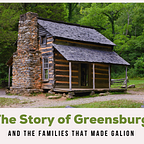Part Seven: All Good Things Must Come To An End
“And every fair from fair sometime declines, By chance, or nature’s changing course untrimm’d.” — Shakespeare, Sonnet 18
In September 1831, just three years after the plat of Greensburg was filed, the plat of Galion was dutifully recorded in Mansfield by Michael Ruhl and Jacob Ruhl. And, in a strange twist of fate, it was signed as well by Justice of the Peace Calvin Dorwin, one of those who had filed the plat for Greensburg.
The newly recorded plat of Galion stretched three lots west of today’s Union Street. As we now know, the platted towns of Greensburg and Galion sat generally side by side, and based on the information learned it is possible to make some general conclusions about what took place between 1828 and 1831 that resulted in this arrangement.
Those theories would include the following:
- There may have been an understanding that the higher ground to the east provided better conditions for growth. It is interesting to note that the plat of Galion extended further to the east than to the west. There may well have been a consensus reached that the swampy land to the north and west would be more of a barrier to growth than land to the south and east. 1
- The higher ground would also have provided natural runoff and, as shared before, a well was already located close to the middle of Galion’s Public Square.
- The Ruhls may well have been better at the task of development and marketing, or had a better network of potential land purchasers. Perhaps the seven Greensburg plat signers were simply out-performed.
- Money and organization may have also played a part. The Ruhls may have been better financed, and with ownership concentrated in one family, may have been quicker on the ground in terms of doing business. 2
When writing for this series began, no information was known about how Greensburg ended. How could a community, once platted, cease to be? The simple answer is by reversing the path in which it was created — namely with an action to vacate the plat and then having the vacation recorded in the county courthouse.
That said, nothing to that effect can been found in the Richland County Courthouse. On a warm summer afternoon in late June 2021, however, the author was doing research in the Crawford County Recorder’s Office for the City of Galion completely unrelated to the subject of this series. Looking in the plat book, his eye caught a word — Greensburg — in a plat index book.
The date of the document referenced in that book was April 3, 1848, a date which immediately made sense.
In 1845, after 25 years of being located in Richland County, all of Section 31, including the platted areas of Grensburg and Galion, was transferred to Crawford County. It stood to reason therefore that the new document would be filed in Bucyrus, not Mansfield. 3
The filing was initiated by three property owners, Jonathan Fellows, Henry Ruhl, and James Gill. Stating that they owned all property included in the original plat of Greensburg, they asked the Crawford County Court of Common Pleas to vacate the same. Required legal advertisement took place in the “People’s Forum” in Bucyrus, forerunning of today’s Bucyrus Telegraph-Forum, and by posting a notice in the busiest Galion store, Davis & Bloomer.
The plat included in the petition was the same as recorded twenty years earlier in Mansfield, with the three petitioners’ names placed next to it to the north (James Gill), west (Henry Ruhl), and south (Jonathan Fellows).
In our last installment, we will take a look at a couple of “loose ends” in our story and makes some final observations.
1 Taking a look at maps of Polk Township and Galion published in 1855 and 1873 (click on the dates to access), it is clear that Galion’s initial growth was almost exclusively to the south and east. Land to the west was clearly disfavored.
2 Many histories of Crawford County talk about the wealth of the Ruhl family. One states, “When John Ruhl arrived from Pennsylvania with his wife and five sons and a daughter, a wealthy man for those days, he purchased much of the land where the town of Galion, Ohio now stands. He had the idea that this land would make an excellent site for a town. “ History of Northwest Ohio, p 401
3 In a twist of fate, one of the three Crawford County Commissioners who authorized the addition of Galion, Crestline, and townships to the north to be added to Crawford County was actually the first cousin of the author’s Great Great Great Grandfather Palmer.
